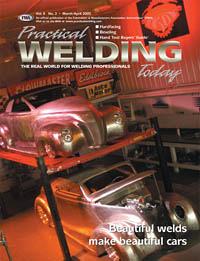- FMA
- The Fabricator
- FABTECH
- Canadian Metalworking
Categories
- Additive Manufacturing
- Aluminum Welding
- Arc Welding
- Assembly and Joining
- Automation and Robotics
- Bending and Forming
- Consumables
- Cutting and Weld Prep
- Electric Vehicles
- En Español
- Finishing
- Hydroforming
- Laser Cutting
- Laser Welding
- Machining
- Manufacturing Software
- Materials Handling
- Metals/Materials
- Oxyfuel Cutting
- Plasma Cutting
- Power Tools
- Punching and Other Holemaking
- Roll Forming
- Safety
- Sawing
- Shearing
- Shop Management
- Testing and Measuring
- Tube and Pipe Fabrication
- Tube and Pipe Production
- Waterjet Cutting
Industry Directory
Webcasts
Podcasts
FAB 40
Advertise
Subscribe
Account Login
Search
Are your weld procedure specifications relevant?
Why compliance is important through a weld inspector's eyes
- By Paul Cameron
- March 8, 2005
- Article
- Shop Management
 |
In fabrication shops that require code or standard compliance, welding sometimes isn't completed within the guidelines of the qualified weld procedure. Weld inspectors often must review finished products that don't make the intended customer happy. Inspectors typically try to answer the following questions to help provide reasons for a client's displeasure:
- Does a weld procedure specification (WPS) cover this product (or joint)?
- What are the operator's qualifications?
- What will an audit of this work center/robotic welding workcell find?
Does a WPS Cover This Product (or Joint)?
A weld procedure is much like the recipe for a successful, high-quality weld. All of the ingredients and instructions should be listed clearly. Before it's used, the recipe should be tested and shown to work.
So where are those recipes? It's common to find the WPS stuffed away in a supervisor's office in a dusty old black binder that hasn't been moved since the last audit. Worse, only one copy—equally dusty—of the American Welding Society D1.1 may be available, and the inspector may be told, "We use the prequalified procedures in there."
Many shops use prequalified procedures. They are good, low-cost tools made available through the AWS. Keep in mind, the second sentence of the scope in the prequalified section says, "All prequalified WPSs shall be written." The steps required and sample forms always are available in the most current copy of AWS D1.1.
A shop can qualify specific weld procedures. Again, AWS D1.1 specifies the steps and provides sample documentation. This method may require the overview of a certified welding inspector (CWI) and access to radiographic, ultrasonic, and tensile testing facilities.
Although costly, procedure qualification testing can be tailored to a shop's specific product or service. Weld procedures also can be purchased from a number of sources for a reasonable cost.
What Are the Operator's Qualifications?
Welder qualification testing often is a condition of employment and the first step to getting in the door. Typically, employers set up testing methods that ensure their welders' qualification. But gray areas start to creep in when shops add welding automation, grinders, and tack welders. Grinding and tack welding positions often are used as springboards for employees interested in welding positions.
Tack welding requires qualification per AWS D1.1. This qualification often is overlooked, yet it is stated clearly in this code. Inspectors may find grinder operators with no welding background or qualification performing fairly significant weld repairs. This often is due to their location in the fabrication process: the end of the line. Grinder operators often are the last to see a product before it's painted. That alone is a good reason to ensure that all grinder operators are qualified welders.
Operators of a fully automated welding process also need qualification. If the operator performs tack welding, adjustments, or
programming, he or she is required to be qualified.
What Will an Audit of This Work Center/Robotic Welding Workcell Find?
Audits are a good way to find out just how "in control" a welding process is. Many questions are involved: Are the WPSs available? Are they being followed? Is the information listed relevant to the process being used?
The following are examples of irrelevant types of information. Assume gas metal arc welding (GMAW) is being used. It's common to find "current" listed on the WPS, yet the control adjustment available to the welder is wire feed speed. With constant-voltage equipment, the welder can monitor only current during welding. It's a great sales pitch for having eyes in the back of your head, but it's not a practical parameter on a GMAW WPS.
Another example: A weld procedure often calls for several different weld settings for a single weldment. Maybe a root pass needs to be put in at 18 volts and 280 inches per minute (IPM) in the vertical-down position. Then the fill and cover passes require 27 V and 650 IPM.
The equipment available to the welder is a wire feeder with a single adjustment for wire feed speed and a power supply located 15 feet above the operator's head. Chances are slim that the welder will be making the required adjustments to the weld setting.
What's more likely to happen is that the welder will find a single weld setting to complete the joint. This setting will be unqualified and not optimal for either required setting. The cost of this setting will be excessive weld spatter, poor side wall fusion and root penetration, poor weld contour (possible stress risers), and perhaps risk of litigation.
A workcell should allow the welder to make machine adjustments without risking his neck. A supervisor should understand the need to review the WPS requirements and ensure they are followed. A production engineer should understand the limitations of the workspaces and provide equipment that accommodates those limitations. A weld engineer should ensure that the WPS he or she develops is relevant and can be used by anyone who refers to it.
By ensuring that welders and processes are qualified, a fabrication shop limits its risk for litigation. Making sure that welders and processes are qualified, that work spaces are operator-friendly, and that documentation is relevant will help make this happen.
About the Author

Paul Cameron
Braun Intertec
4210 Highway 14 East
Rochester, MN 55904
About the Publication
subscribe now

The Welder, formerly known as Practical Welding Today, is a showcase of the real people who make the products we use and work with every day. This magazine has served the welding community in North America well for more than 20 years.
start your free subscription- Stay connected from anywhere

Easily access valuable industry resources now with full access to the digital edition of The Fabricator.

Easily access valuable industry resources now with full access to the digital edition of The Welder.

Easily access valuable industry resources now with full access to the digital edition of The Tube and Pipe Journal.
- Podcasting
- Podcast:
- The Fabricator Podcast
- Published:
- 04/16/2024
- Running Time:
- 63:29
In this episode of The Fabricator Podcast, Caleb Chamberlain, co-founder and CEO of OSH Cut, discusses his company’s...
- Industry Events
16th Annual Safety Conference
- April 30 - May 1, 2024
- Elgin,
Pipe and Tube Conference
- May 21 - 22, 2024
- Omaha, NE
World-Class Roll Forming Workshop
- June 5 - 6, 2024
- Louisville, KY
Advanced Laser Application Workshop
- June 25 - 27, 2024
- Novi, MI































